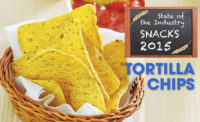Whether it’s a traditional meal at a full-service Mexican restaurant or a new creation from a fast-casual chain—think Taco Bell’s Grilled Stuft Nacho or On the Border Mexican Grill & Cantina’s Border Bowls—Americans continue to seek out Mexican food in unprecedented numbers.
Overview | Bread | Tortillas | Sweet Goods | Snack Cakes | Pizza | Desserts | Cookies | Buns & Rolls | Bars
In fact, Technomic Inc., Chicago, states in its recent “Top 150 Fast-Casual Chain Restaurant Report” that the Mexican category is one of the fast-casual segment’s most-developed and mature clusters, posting gains of about 18 percent in sales and 6 percent in locations in 2014. With the well-known chains—Taco Bell, Chipotle Mexican Grill, On the Border, Moe’s Southwest Grill, Baja Fresh, Del Taco and others—opening new locations seemingly everywhere, these findings aren’t surprising.
Restaurants, however, are just part of Mexican food’s U.S. success story. Many home cooks enjoy preparing Mexican dishes for themselves and their families, so much so, in fact, that they spent $2.26 billion on hard and soft tortilla and taco kits, $251.8 million on refried beans and $60 million on other Mexican food items during the 52 weeks ending April 19, 2015, according to IRI, Chicago.
More consumers continue to use tortillas in creative ways—in breakfast recipes, as a sandwich bread replacement and as a portable dessert component. And those exploring other international cuisines are finding that tortillas make suitable substitutes for all kinds of flatbreads.
Market data
This is all good news for manufacturers of Mexican consumer and foodservice products, and it’s great news for tortilla manufacturers, especially those keeping up the latest consumer trends and delivering relevant new products.
Case in point: Olé Mexican Foods, Chicago, saw sales of its Xtreme Wellness! soft tortilla wraps jump 134.4 percent—to $15.8 ?million—for the 52 weeks ending April 19, according to IRI. The line comprises 8-inch High Fiber, Fat Free, Spinach & Herbs, Tomato & Basil and Multigrain Tortilla Wraps. Products high in fiber, fat free and made with recognizable ingredients are topping consumers’ shopping lists.
Olé Mexican Foods also offers corn and white corn tortillas, flour tortillas, flatbread and other items under its Olé brand, and corn and flour tortillas and tostadas under the La Banderita brand. The Olé brand saw sales drop 21.4 percent for the 52 weeks ending April 19, while the La Banderita brand saw a sales increase of 7.67 percent for the same period.
Taco Bell, a Kraft Foods Group Inc. brand, saw sales increase 116 percent—to $27.5 million—for the 52 weeks ending April 19. The company offers a variety of hard and soft taco dinner kits, as well as taco dessert kits in chocolate and cinnamon, two trending flavors.
Other companies and brands seeing strong sales percentages in tortillas and taco kits category for the 52 weeks ending April 19 were La Tortilla Factory, with a 28.4 percent sales increase ($30.4 million); Mission Foods North America’s Mission Carb Balance line with an increase of 16.6 percent ($66 million); and General Mills’ Old El Paso Stand ’N Stuff Shells, with an increase of 16.4 percent ($45 million).
The following five brands to record the biggest dollar sales in the category for the period were: Mission, $578.1 million; Guerrero, a Gruma, S.A.B. de C.V. brand, $334.1 million; private label $207.1 million; La Banderita, $162.5 million; and Old El Paso $159.5 million.
Brands recording sales of more than $1 million in the refrigerated tortilla segment that saw the biggest percent sales decline, per IRI, were Azteca Buena Vida, down 38.17 percent, to $1.1 million; Pepito, down 25.4 percent, to $2.4 million; Mex America, down 21.93 percent, to $1.3 million; Cruz, down 16.65 percent, to $5.8 million; private label, down 12.04 percent, to $16.8 million; and Don Marcos, down 11.43 percent, to $2.12 million.
Brands recording sales of more than $1 million in the refrigerated tortilla segment that saw the biggest percent sales increase for the period were De San Diego, up 76.8 percent, to $1.3 million, and TortillaLand, a Circle Foods LLC brand, up 34.8 percent, to $19.3 million. Circle Foods was purchased by Tyson Foods in 2013.
Overall, the refrigerated tortillas segment generated $107.7 million in sales for the 52 weeks ending April 19, down 5.08 percent, per IRI.
Looking back
Americans’ love of Mexican foods isn’t the only driver of U.S. tortilla sales. Given tortillas’ relatively short ingredient list, they’re also popular with many health-conscious consumers.
“It is no secret that consumers are making choices about what they consume,” says Julie Nargang, vice president of marketing/innovation, Azteca Foods Inc., Chicago. “Topping these choices are products that address health and wellness.”
To answer consumers’ quest for such products, the company launched its “healthier for you” platform last year. The platform is anchored by four Azteca No Preservative flour tortilla options. Other offerings are Organic and Ultragrain tortillas, and tortillas with added calcium and vitamin D. All can be found in grocers’ refrigerated section.
“We have been having a lot of success with ‘better-for-you’ offerings—non-GMO, certified-organic and ‘all-natural,’ which would be preservative-free,” says Ricardo Baez, president of Don Pancho Authentic Mexican Foods Inc., Salem, OR. “We are also seeing more folks ask for products to be made with vegan and natural ingredients.”
Tom Jondiko, Ph.D., R&D food scientist, Allied Blending & Ingredients, Bell, CA, says consumers’ health concerns and awareness of the benefits of healthy eating have resulted in increased requests for low-sodium, low-fat and gluten-free tortillas.
While corn tortillas are gluten-free, some people with gluten sensitivities still hanker for flour tortillas. Fortunately for these consumers, the number of gluten-free flour tortillas on the market continues to grow. Mission Foods North America, Irving, TX; La Tortilla Factory, Santa Rosa, CA; Rudi’s Organic Bakery, Boulder, CO; Udi’s Healthy Foods LLC, Denver; and others offer gluten-free tortillas.
“Gluten-free is a category that’s coming on board,” says Baez. His company offers a gluten-free product that he categorizes as “a better-for-you or specialty item” that’s in demand.
Another factor driving tortilla sales, says Jondiko, is shifting food trends toward whole-grain and multigrain products. “Wheat tortillas are the most popular—51 percent—with the consumer, in general,” he notes. “Corn tortillas are a close second (49 percent), mainly due to the increasing Hispanic population who prefer corn tortillas.”
Kevin Kelly, director for Allied Blending’s Tortilla Group notes, “White, fluffy tortillas for retail are the most popular.”
At Don Pancho Authentic Mexican Foods, basic corn and flour tortilla both still drive sales, says Baez. “I would say that this is the rule for most of the major players in our industry, with the exception of a couple of the boutique or small tortillerias that are engaged in our business,” he notes. “In terms of what’s really driving the category—much like for the bread people—it’s driven by the staples.”
But some consumers want more than just a basic corn or flour tortilla—and they’re letting manufacturers know. Jondiko cites savory spinach, sun-dried tomato basil, and jalapeño and cheese as current popular tortilla flavors. He adds that increased demand for “bold and spicy flavored tortillas, especially for the Southwestern states,” is on the horizon.
Kelly also says that spinach and dry tomato are current popular tortilla flavors, with very spicy being a trend.
Like other food manufacturers, tortilla producers turn to their ingredient suppliers to create tortillas to meet current consumer trends and demands.
“On the ingredient side, tortilla manufacturers are looking for more label-friendly ingredients, while retaining the current quality of their tortillas,” says Steven Baker, senior food scientist, TIC Gums, White Marsh, MD. “This movement has led to increased interest in utilizing enzymes and more natural dough conditioners, such as gums.”
Baker adds that manufacturers also frequently request identity-preserved variants of current ingredients, such as organic-certified. “The certification is important for consumers, the industry and the regulatory community in order to assure organic integrity from farm to retail shelf,” he says.
Jondiko notes that tortilla manufacturers are looking for clean-label ingredients, but also adds non-GMO, organic and natural ingredients, whole grains, fibers, and starches for low-carb and gluten-free tortillas to the list.
However, using new or different ingredients in their tortilla formulations can sometime result in new challenges for manufacturers.
“Refined wheat flour contributes to highly desirable tortillas in a number of ways, such as producing dough that is both elastic and extensible and a finished tortilla that retains its softness and pliability over time,” explains Baker. “When switching to alternate flours that act differently than refined wheat, common quality issues arise, such as shorter shelf life due to drying out more quickly and cracking during rolling or folding. Gums help alleviate these issues by managing the water in the formula. Water management allows these tortillas to have a more moist texture initially, while retaining their pliability over time.”
According to Jondiko, the main challenge tortilla manufacturers can face when using alternative ingredients is “the staggering high cost of the ingredients compared to conventional ingredients. Secondly, the supply chain is not fully established to sustain the increased demand for these ingredients. The stringent expectation of having to dedicate a processing line or having to ensure complete sanitization of lines to produce gluten-free tortillas is a challenge that slows down the implementation of such projects by most tortilla manufacturers.”
Looking ahead
The outlook for the tortilla category is positive. “The tortilla category will continue on its upward trajectory,” says Nargang. She cites several consumer and environment factors that support this trajectory: the continued popularity of Hispanic meals, the increased popularity everywhere of tacos or “street tacos,” the versatility of the tortilla, and the use of tortillas as a bread alternative.
“The category is projected to grow steadily, having outsold sandwich bread in 2010 with record U.S. annual sales of $11 billion in 2012,” says Jondiko. “New markets will open up in Europe, Asia and parts of Africa for tortillas.” He adds that organic tortillas will become mainstream food in the U.S. as more major stores like Costco offer organic tortillas. The adoption of tortillas into the Special Supplemental Nutrition Program for Women, Infants, and Children (WIC) program also will lead to an increased consumption of tortillas.
“The trend that we’ve seen is continued growth and opportunities for tortillas and tortilla-related categories in nontraditional settings,” says Baez. “We view tortillas as a transporter of great foods from around that world. That is really what the evolution of the tortillas is now.” She says that it doesn’t matter what you put in a tortilla, “it’s just a great transporter of great foods from different parts of the world.”
Overview | Bread | Tortillas | Sweet Goods | Snack Cakes | Pizza | Desserts | Cookies | Buns & Rolls | Bars












